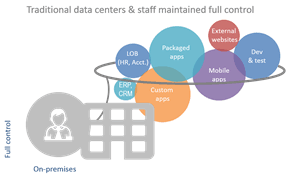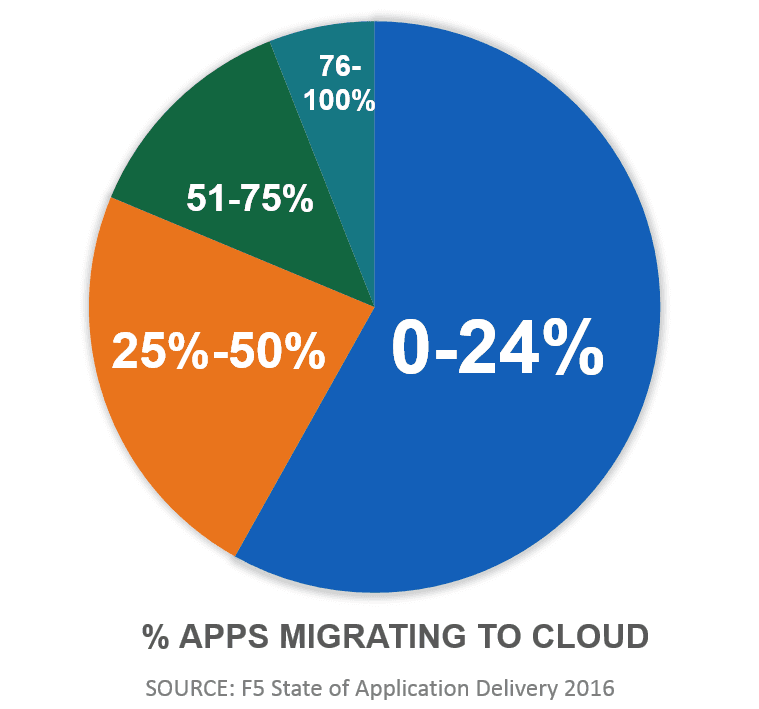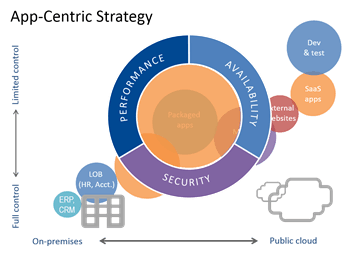
Back in the old days, applications were centrally managed under a single infrastructure. Data center boundaries provided protection and were easily identified. IT staff were tasked with ensuring availability, performance, and security of all applications.
IT had full control over every aspect of an application’s lifecycle and deployment.
But as they say that was then, this is now. Today apps are continuing their migratory path to private and public clouds. CIOs are trading control for agility and cost savings and applications are increasingly deployed off-premises in a variety of cloud-based models.

The majority of organizations are migrating up to half their applications to the cloud. Line of business apps are responsible for a significant portion of those migrations as SaaS continues to be the most popular of cloud models, but the movement doesn’t stop there. Private and public IaaS models are increasingly desirable for the exploding number of mobile applications.
Today IT has to develop, deploy, and ensure availability, performance, and security of applications across an increasingly diverse set of environments. And it’s not just for “mission critical” applications. In an app economy where the currency is measured is downloads and engagement rates, every application has to be fast, it has to be secure, and it has to be available.
Every. Single. App.
What hasn’t changed is that organizations continue to rely on application services to ensure security, performance, and availability. Whether it’s basic load balancing or a suite of application optimizations or application security, the one truth remaining as cloud forces everything else to change is that apps need those services – no matter where they are deployed. That means adopting an app-centric strategy for all applications, including those moving to the cloud.
App-Centric Strategy
Cloud is a forcing function. It’s driven IT to change business models, network architectures, deployment methodologies, and even preferences for hardware or software. It should be no surprise, then, that’s it also forcing strategic changes to how organizations secure and deliver applications. It’s not enough to settle on a “cloud first” strategy, it’s got to focus in on the app, too. It’s not really a successful strategy if it cuts operational costs by going to the cloud but incurs others with reduced productivity or lost profits thanks to poor performance.

A net of 0 (if you’re lucky) isn’t success. It’s just moving numbers around on the ledgers.
What’s needed is an app-centric strategy. One that ensures consistent delivery services for every app regardless of deployment model. A strategy that abstracts away the complexities of disparate cloud environments and enables continued use of skills and policies while supporting a DevOps approach.
It’s a strategy that starts with applications and ends with success.
It’s that strategy that drives us to continue to expand and innovate, improving delivery and security services delivered by BIG-IP and management and orchestration capabilities offered by BIG-IQ so that you can successfully execute on an app-centric cloud strategy. No matter where an app might be deployed – in the cloud, on-premises, or as a Service – it needs services to ensure its performance, security, and availability. And you need to be able to consistently deploy and manage those services.
F5: Enabling Success of the App-Centric Strategy
And that’s why today We (as in the corporate We) are pleased to announce a variety of improvements, enhancements, and new additions with BIG-IP 12.0 to support organizations successfully delivering on just such an app-centric strategy.
BIG-IP 12.0 offers modern application security options including SSL Everywhere, expanded fraud protection, improved SSO with leading SAML enhancements supporting browser-less environments like Office 365, and modern cryptographic cipher support like ECC, FS and camellia for enhanced privacy and message integrity. Hyperscale DNS with extended caching capabilities and HTTP/2 gives business the ability to improve performance of web and mobile apps on-premises and in the cloud without requiring expensive changes to applications.
F5 continues to expand orchestration and management options across private and public cloud, SDN and traditional environments with BIG-IQ and BIG-IP. Microsoft Azure joins an already extensive ecosystem including Cisco ACI, VMware NSX, and OpenStack, VMware vCloud Air, and Amazon Web Services. Supportive of cloud and DevOps initiatives, F5 is bringing new and enhanced programmability tools to complement our already broad set of software options including our virtual, lightweight load balancer, LineRate Point. DevOps practitioners rely upon APIs and data path scripting for automation efforts and to support them we’re now offering an iRule editor and enhanced iControl APIs.
All of these improvements, enhancements and additions (as well as the other ones not specifically mentioned) are designed to enable all of IT – from dev to ops to network to security – to successfully develop and execute on an app-centric strategy as they continue to expand their horizons (and app deployments) into the cloud.
About the Author

Related Blog Posts

AppViewX + F5: Automating and orchestrating app delivery
As an F5 ADSP Select partner, AppViewX works with F5 to deliver a centralized orchestration solution to manage app services across distributed environments.

Build a quantum-safe backbone for AI with F5 and NetApp
By deploying F5 and NetApp solutions, enterprises can meet the demands of AI workloads, while preparing for a quantum future.

F5 ADSP Partner Program streamlines adoption of F5 platform
The new F5 ADSP Partner Program creates a dynamic ecosystem that drives growth and success for our partners and customers.
F5 NGINX Gateway Fabric is a certified solution for Red Hat OpenShift
F5 collaborates with Red Hat to deliver a solution that combines the high-performance app delivery of F5 NGINX with Red Hat OpenShift’s enterprise Kubernetes capabilities.
F5 Silverline Mitigates Record-Breaking DDoS Attacks
Malicious attacks are increasing in scale and complexity, threatening to overwhelm and breach the internal resources of businesses globally. Often, these attacks combine high-volume traffic with stealthy, low-and-slow, application-targeted attack techniques, powered by either automated botnets or human-driven tools.
Phishing Attacks Soar 220% During COVID-19 Peak as Cybercriminal Opportunism Intensifies
David Warburton, author of the F5 Labs 2020 Phishing and Fraud Report, describes how fraudsters are adapting to the pandemic and maps out the trends ahead in this video, with summary comments.
